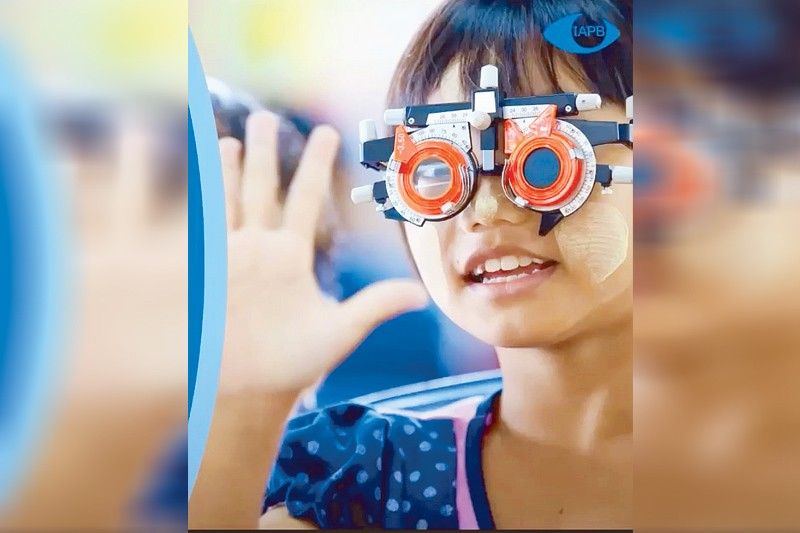2030 in sight: Helping people open their eyes to a better tomorrow


When it comes to eye health, we should never take chances.
This I realized while listening to Dr. Nelson Yu, an eye specialist, as he explained to my 74-year-old dad last Wednesday why he needed to undergo the fundus photography procedure and biometry test before undergoing cataract surgery.
My dad is also a diabetic. And many patients seeking cataract surgery have coexisting diabetic eye disease.
Sure, cataract surgery can restore vision. But when there is co-existing diabetic eye disease, the surgery may put additional stress on the eye. Dr. Yu must look carefully at his retina for other causes of visual loss rather than old age.

Supporting eye health beyond COVID
If you begin to see lots of floaters — flashes of light and a dark curtain beginning to cross into your vision— get to the doctor in a hurry. Being proactive about your condition could mean the difference between reversing the damage and losing your eyesight.
My dad first complained of blurry vision (even with his glasses on) in 2020. He was scheduled to undergo a comprehensive eye exam, but the pandemic hit. As part of the vulnerable category (because of his age and comorbidities), it was a choice of saving his eyesight or saving his life.
The coronavirus pandemic has compounded the problem of eye health in the country. While the country hasn’t flattened the curve yet, the number of patients with eye health concerns continues to rise.
“It could take significant efforts to educate patients that they must prioritize eye care and get back to receiving care,” stressed Dr. Rachel O’Neale, Country Pharma Organization head, Novartis Vietnam, at the virtual forum on “How Can 2030 In Sight Support Eye Health Beyond COVID?” via Zoom.
Convened by the International Agency for Prevention of Blindness (IAPB), in collaboration with Novartis, the virtual forum aims to consolidate partners’ efforts in building on key takeaways from the one-year Collaboration to Preserve Sight initiatives across Indonesia, the Philippines, and Vietnam during the pandemic.
As of December 2021, the Collaboration to Preserve Sight initiative reached one million people through awareness initiatives; screened 78,000 patients; detected vision impairment among 11,000 patients; facilitated 7 out of 10 diagnosed patients to seek consultation; treated six of 10 patients or over 4,700 patients; launched social media platforms for patient education and screening schedules; and formed external partnerships with over 370 patient and medical organizations, NGOs and policymakers.
“We thank our partners for enabling the Collaboration to Preserve Sight initiative to have a meaningful impact, with six out of 10 people in vulnerable communities seeking consultation and receiving treatment despite pandemic restrictions. The initiative demonstrates that intensified screening coupled with innovative patient education facilitates the patient journey to sight preservation,” said Christine Fajardo, Asia Cluster Patient Engagement Lead and Corporate Affairs head for Novartis Healthcare Philippines, Inc.

It takes a village to move forward
“What it took to get us to this point where we are emerging out of the pandemic was a lot of sacrifice,” said Ruth Kugur, APMEA Region Communications and Patient Engagement head, Novartis.
“And so, post-pandemic, it will also take a village. And we need to work together to continue the mindset shift of all players: the government, patients and healthcare professionals,” she added.
The Collaboration to Preserve the Sight Initiative has clearly demonstrated that intensified vision screening really works.
Novartis has organized community events, of course, with safety protocols. This has been supported by online education, social media advocacy campaigns, remote monitoring, and the primary clinics, which really has enabled us to conduct small-scale screenings at higher frequency in places that they wouldn’t ordinarily be able to get to.
“As an example, last year I learned about Edwin, a construction worker in the Philippines, who lost his job because of his failing eyesight, shared Kugur. “He was the breadwinner of the family so he was consumed with the guilt of letting his family down.”
Through the Collaboration to Preserve Sight initiative, Edwin received cataract surgery and was able to get back on his feet.
“It was interesting to hear that they call Edwin’s story a miracle,” enthused Kugur. “And I think we can all agree that these kinds of miracles only happen if we develop strong, sustained and focused partnerships post-pandemic.”
Moving forward, Dr. Rachel O’Neale, Country Pharma Organization head, Novartis Vietnam, said reassuring patients about their personal safety is a very new challenge for the healthcare system and medical frontliners as they attempt to make the return to normal.
“As for patients, we need to educate them about the need to be proactive with their eye health and reengage with their doctors and carers quickly. And this is even more profound as you get out of the big metropolitan cities and into more rural drop-off,” she added.
To which Dr. Noel Chua, chairperson of the National Committee for Sight Preservation (NCSP), added: “The pandemic has greatly worsened existing inequalities in access to eye care services.”
In the Philippines, six million people are waiting for long-term action from the government.
“The COVID-19 pandemic has exposed and even magnified the weakness in our national health system,” lamented Dr. Maria Victoria Rondaris, Philippine country manager, The Fred Hollows Foundation. “As we all know, eye health is not a priority in the national government as is in other parts of the world.”
Though established decades before, the Philippine Prevention of Blindness Program has made slow, significant strides despite little support and importance.
“And based from local and international experience, incorporating eye health into the wider health systems meant working together primarily with governments and also with like-minded stakeholders to provide support and sustainability, explains Rondaris. “Yet, the government must appeal mainstream eye health in the Universal Health Care (UHC) implementation signed in 2019.
When asked what should be done to better lobby and engage policymakers to ensure better funding for eye health as we emerge from the pandemic, Dr. Harvey Uy, president of the Vitreo-Retina Society of the Philippines, hastily replied: “Just two things: Find connections in the government, and don’t give up.”
2030 In sight: Preventing avoidable sight loss
Every minute, one person goes blind. In the Philippines, over two million people suffer from vision impairment. In Vietnam, more than 300,000 adults and 25,000 children are blind, while 3.5 million suffer from vision impairment in Indonesia.
“‘2030 In Sight’ is the IAPB strategic plan to ending avoidable sight loss for the next decade,” explained Amanda Davis, chairperson, IAPB, Western Pacific.
Its three key objectives are:
• By 2030, no one experiences unnecessary or preventable sight loss and everyone can achieve their full potential.
• Eye care rehabilitation services are accessible, inclusive, and affordable to everyone, everywhere, whenever they are needed.
• People understand the importance of caring for their own eye health and demand access to services, free from the weight of social stigma.
“It takes the evidence and know-how generated over the past 30 years, leverages the significant political momentum that eye health stakeholders have generated and lays out an ambitious approach that will guide their work until 2030 and beyond,” added Davis.



















